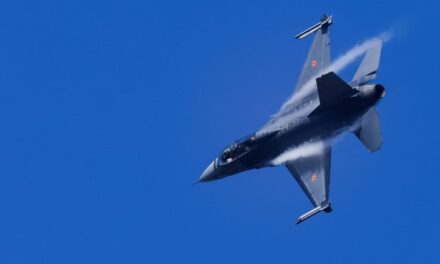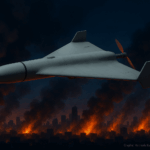In the ever-evolving landscape of military technology, the HESA Shahed 136, also known as Geran-2 in Russian service, has emerged as a formidable loitering munition developed by Iran’s Shahed Aviation Industries. This autonomous pusher-prop drone has garnered attention for its unique design and strategic deployment capabilities.
The Shahed 136 is designed to engage ground targets from a distance, offering a potent tool for military operations. Launched in batches of five or more from a portable rack, its purpose is to overwhelm air defenses by launching multiple attacks, thereby consuming the resources of the targeted defenses. The first public glimpse of this drone was unveiled in December 2021, showcasing its sleek and innovative design.
This loitering munition boasts a distinctive cropped delta-wing shape, featuring a central fuselage seamlessly merging into wings with stabilizing rudders at the tips. The nose houses a warhead weighing between 30 to 50 kilograms, while a two-bladed pusher propeller, powered by an Iranian-made Mado MD-550 four-cylinder piston engine, propels the drone. With a length of 3.5 meters, wingspan of 2.5 meters, and a speed exceeding 185 kilometers per hour, the Shahed 136 weighs approximately 200 kilograms.
One key feature is the drone’s portability, allowing the entire unit, including the launch frame and drone assembly, to be mounted on military or commercial trucks. The drone is launched at a slight upward angle and receives initial flight assistance from rocket launch assistance (RATO). After launch, the drone transitions to its conventional engine for sustained flight.
While lacking external markings, experts believe the Shahed 136 incorporates a computer processor from the American company Altera, RF modules by Analog Devices, and LDO chips by Microchip Technology. Notably, some components used in the drone’s electronics were found to be of foreign origin, including a Texas Instruments processor, a Polish-made fuel pump, and a voltage converter from China.
In Russian service, the Shahed 136 takes on the name Geran-2, reflecting modifications that include a Russian-manufactured flight control unit and microprocessors. The adaptation involves the use of the Russian GLONASS GNSS system instead of U.S. civilian-grade GPS, enhancing its loitering munition capabilities. The Geran-2 is distinguishable by labeling and paint color matching Russian munitions.
The Shahed 136 gained notoriety during the 2022 Russian war in Ukraine. Initially mistaken for a Russian-made drone, it was later confirmed as an Iranian design. The Ukrainian military reported successfully intercepting numerous Shahed 136 drones, employing a variety of strategies, including small-caliber ground fire and dedicated air-defense systems. The cost-benefit analysis of using these drones favored their deployment, proving more economical than the defenses employed against them.
Recent developments suggest an evolution in the Shahed 136 series, with a jet-powered version revealed in September 2023. This new variant, powered by a turbojet engine, aims to enhance speed and altitude, making interception more challenging. Additionally, it features a nose-mounted camera for improved navigation and terminal guidance.
The international response to the Shahed 136 has been complex. The U.S. State Department accused Iran of violating UN Security Council Resolution 2231 by selling drones to Russia. Diplomatic ties between Iran and Ukraine were strained, and Iran denied sending arms for use in the Ukraine war. Despite criticisms of its tactical usefulness, the Shahed 136 has found a place on the global stage, shaping discussions on the future of military technology.
As the Shahed 136 continues to evolve and be employed in various conflict zones, it stands as a testament to the ever-changing landscape of autonomous weaponry, prompting nations worldwide to reassess their defense strategies.












